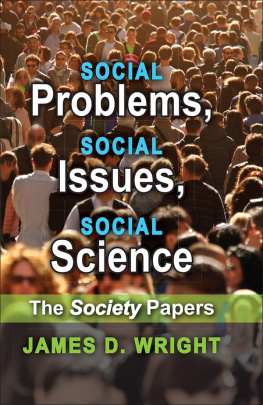First published 1986 by Transaction Publishers
Published 2017 by Routledge
2 Park Square, Milton Park, Abingdon, Oxon OX14 4RN
711 Third Avenue, New York, NY 10017, USA
Routledge is an imprint of the Taylor & Francis Group, an informa business
Copyright 1986 by Richard F. Hamilton and James D. Wright.
All rights reserved. No part of this book may be reprinted or reproduced or utilised in any form or by any electronic, mechanical, or other means, now known or hereafter invented, including photocopying and recording, or in any information storage or retrieval system, without permission in writing from the publishers.
Notice:
Product or corporate names may be trademarks or registered trademarks, and are used only for identification and explanation without intent to infringe.
Library of Congress Catalog Number: 2008003960
Library of Congress Cataloging-in-Publication Data
Hamilton, Richard F.
State of the masses : sources of discontent, change and stability / Richard F.
Hamilton and James D. Wright.
p. cm.
Originally published: New York : Aldine, c1986.
Includes bibliographical references and index.
ISBN 978-0-202-36187-1
1. United StatesSocial conditions1960-1980. 2. Public opinionUnited States. I. Wright, James D. II. Title.
HN59.H244 1986b
306.097309045dc22 |
2008003960
|
ISBN 13: 978-0-202-36187-1 (pbk)
We have borrowed the title. It comes from a book by Emil Lederer, one first published in 1940. The title, we thought, contains a useful idea, that is, the need for a summary portrait, for a picture of the social conditions, outlooks, and leading motives found within the masses. Although we do not agree with the fundamentals of the portrait Lederer provided, we do, obviously, like and appreciate the essential idea.
The word masses, in most formulations, is accompanied by rather unsavory predicates. The masses are said to lack intelligence, character, and constancy of purpose. They are gullible, easily led, subject to manipulation, and are moved either by zealous demagogues or by scheming elites. On the side of the angels today, tomorrow the masses could easily be in the sway of a self-declared peoples tribune. The alternative reading sees them caught up by the latest mass media offering. Here the complaint is about their inactivity, their torpor. They are immobilized, transfixed, refusing to work toward the higher synthesis that some astute analyst has discovered to be close at hand.
An obvious correlate to this deprecation of the masses is the claim that some other segment of the population is behaving in an opposite way, showing intelligence, self-sacrifice, and responsibility. The most frequent references are to traditional upper classes (or elites), to those doing what they can to channel unpredictable mass demands, or to engage intellectuals, to those who, out of a generous, public-spirited concern, offer guidance and direction to the masses.
We do not acceptat least not as a priori stipulationsthe elements of the above depiction. We did not wish to prejudge any of the empirical questions involved in the drawing of a social portrait. From the outset, therefore, we sought to remain open to other readings. Following the basic Cartesian principleskepticismwe were willing to entertain opposite hypotheses, such as the possibility of reasonable masses and the possibility of gullible or manipulated elites and/or intellectuals.
In keeping with that skepticism, our use of the term masses differs from that found in most discussions of the mass society. Throughout the book we are referring either to the population of the United States in its entirety or, more frequently, to the nations adult population. Our discussion, therefore, embraces all segments, manual, nonmanual, and farm. The upper-middle-class masses appear there along with the working-class masses. Also included is a tiny segment, a minuscule portion of the whole, but still a large absolute number, the hundreds of thousands who form the upper-class masses. It also includes a somewhat larger collectivity, the masses of intellectuals.
One can, in most seasons, find many competing depictions of the state of the masses. This work deals with some that were current in the 1970s. As of this writing, some five years into the 1980s, most of those depictions no longer have any popular resonance. A famous work by Charles Reich, a smash best-seller in the early 1970s, is now no more than a nostalgic memory for some. For others, for those too young to have experienced the event, even recognition of the name is a rarity. This raises a simple question: why have we taken up such ancient concerns?
A first reason is that of historical interest: we were interested in establishing, as best we could, what actually happened. If one were to depend on the claims made in the course of that decade, an array of contradictions would be an early discovery. Against the claims of Charles Reich, for example, are those put forward by Richard Scammon and Ben Wattenberg. A principal task, therefore, has been that of assessment, to ascertain which of the claims have proved valid. Another possibility, of course, is that both contradictory claims are mistaken; they might both involve a misreading of the state of human affairs at the time.
A second reason for this exploration is to see if the experience of the 1970s does not contain some more general lessons. Several of the major claims reviewed and discussed here reflect (or are derived from) one or another general theoretical orientation. Our review and assessment, therefore, will have implications for those general theories. Our task, therefore, goes beyond mere scorekeeping. We wish to see if the lessons contained in that experience can guide us in our understanding of the human condition at other times and in other places. Part of our effort, as will be seen, is to spell out a more adequate theory, one that, we hope, will be more realistic and have more general application.
A third consideration that has motivated us is a concern with the sociology of knowledge. In some instances, as will be shown, a viewpoint gained wide currency (we cannot be sure of acceptance) although based on the most casual of all possible research methods. One viewpoint, another that gained wide currency, achieved that following even though it stood in sharp opposition to a very extensive body of research findings. One of our tasks, therefore, has been to explain or account for the development of these otherwise unexpected understandings of things and for their popular resonance.
People are trained (in a Pavlovian sense) to see things in given ways. They learn basic paradigmsschemes allowing them to categorize and simplify a wide range of otherwise troublesome experience. People are also trained, in the same way, to approve or disapprove of data sources or research styles. Some of this training takes the form of common sense guidelines, as for example, when people reject all content provided by a fast talker. Other people, some of them fast talkers, operate with a similar casual methodological guideline. Leading intellectual journals rarely mention statistics or polls or surveys without some accompanying terms of denigration. That reaction, we feel, is as unthinking as the former procedure. On the whole, we think, the rejection of the fast talker has more justificationthe aim is to protect relatively defenseless populations from the detrimental effects of various merchandisers, the sellers of dubious commercial, political, or cultural goods. That intellectuals should defend prejudicial procedure is, we feel, something of a disgrace.










